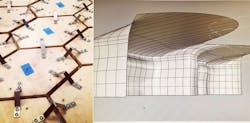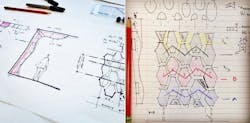Architectural Technology
Architectural technology is changing how architects work, and what’s "in" today might be irrelevant by next week—but ignore these developments at your own peril. Even for your average, run-of-the-mill architect, technology is a way of life. But despite knowing this information, I am frequently amazed by just how amazing technology actually is and the role it plays daily in my work and my office.
A couple of ground rules I think are in order. I thought about having a specialist on the show but then the show could quite possibly become centric to whatever the specialist specialized in … I wanted this conversation to be more of a general discussion about how technology is changing the way we practice architecture.
Is technology impacting the appearance of our projects? [06:21 mark]
What about the performance? Has the implementation of technology really impacted the world of architecture? This is a two-fold question because in one way the answer is a definite yes. We have more data and create, use and analyze more data today in the creation of our projects than ever before. So today, projects are being influenced by technology in that manner. But it does not seem to have overly affected the physical forms of our work. While there is a portion of newly built work is pushing the envelope with regards to forms and materials and parametric design, that is still a small portion. So technology is changing the field of architecture and we are not certain if this is a positive, a negative or a neutral?
The use of BIM [11:16 mark]
The use of historical data and BIM to advise clients on what is possible when it comes to a project’s design, cost, and duration with a high surety factor. It is a challenge to accurately predict the length of time a task takes, yet every day we take leaps of faith and sign ourselves up for projects that may be impossible to achieve. Often, we rely on gut instinct rather than using readily available data to make informed decisions to improve projects. Some of this is a cultural problem but it is also a challenge to understand what to do with data. The use of BIM software across all consultants, syncing to the cloud in real-time – some firms might be there but this is a cost issue for almost all of the firms out there unless they’re gigantic. This is really a bandwidth issue – paying for bandwidth. The number of active projects and the number of people even internal to our own office represents a problem. Andrew might disagree. It is not overly expensive to achieve. In this case, I think for larger firms it is more cost-prohibitive than in smaller ones due to the total volume needed although smaller firms might not have the bankroll to accommodate even this sort of investment, even at a smaller capacity.
Are we over-documenting projects? [06:21 mark]
The increase and ease of technology has made it so that we can produce even more documentation quicker than before. Does that make it a good thing? While we may not agree on the idea of “over-Documentation” Bob and I do realize that additional information must be relevant. It should not be a case of just because we can, we do. The ability to easily create documentation must still maintain the right reasons for doing so. If you cut 40 sections through a building … do you need them all? Would two provide all the relevant information? This still must be a consideration when documenting our projects. BIM was touted as a way to create “better” architects in its origins. The notion that you would need to know more about the models you were creating was meant to require more knowledge on the designer’s part. Did that happen? Does technology make us better architects? We are not certain that the software and technology have made it so.
What about technology at school versus the real world? [29:20 mark] (Grasshopper and Rhino)
I’ve just returned from visiting a handful of architectural programs around the country while on “Career Fair-Fest 2020”. While this process was illuminating from a myriad of angles, I was rather amazed by the number of students who create the vast majority of their drawings within Rhino: Grasshopper only to import it into Illustrator, and then export to PDF or Photoshop for finish work. The rationale for the use of those pieces of software as opposed to those more utilized in the profession is still a bit of an unknown to both of us, but we take a few guesses.
I’d like to think I get out of my box every now and then and during all my conversation and worldly travels, I have only met 1 person who shared with me that Grasshopper was an active part of their professional design process … so why are students using this software? I know there are viable answers to my question but there seems to be a real-world disconnect happening here.
Real value software – [33:38 mark]
This is a name given to software that we believe has value to the workforce. Examples like Bluebeam, SketchUp, Twinmotion 2020, BIM, Adobe Suite (Photoshop, InDesign) are applications that get utilized almost every day in most architectural firms in some form or another. Yet many students do not have a working knowledge of them and the need for them to “add” to the workforce from the drop. We both agree that these are almost “essential” to the knowledge bank of anyone in the profession. I think while some of them are easier to incorporate, others are not truly design-oriented but task-oriented or workflow and therefore a bit more difficult to incorporate into the education process during architectural school. So there exists a group fo other software and applications that are not specifically for the “Traditional” design process but are invaluable to have in your architect’s skill set.
How fast does technology become irrelevant? [40:27 mark]
I did a Google search on technology for architects and a handful of articles came up (123 million actually) and of the first few I clicked through, almost all the platforms discussed appear to be dead, abandoned, or unused. One was titled “9 Cutting Edge Technologies for Architects” and nobody I asked has ever heard of them … and this article came out 2017 – 2 ½ years ago. Laptops, desktops – have they tapered off? It used to be that your computer was a relic after virtually no time has passed. It seems that at the moment we have reached equilibrium on the software needs and hardware speeds. For quite some time the software was outpacing the hardware and your two-year-old computer was outdated and ready to be replaced. In the past 5-7 years, this trend has seemed to slow down a bit as the hardware has caught up with the software needs and you can use your equipment for longer than in the past. What will be the next big push that changes the scales once again? What does the future hold in this aspect? We both have some ideas, but for certain they will be proved wrong in the time to come.
Okay – it’s time for this episode’s hypothetical question. This particular question has was sent in by Jason Shannon from J_Spy Architecture – his question: [45:30 mark]
"Option 1, you have the choice of being an artist who is very successful in your lifetime. You are both wealthy and lauded by the public and your peers during your life, but soon after you die, your work is seen as a fad and you are forgotten. Option 2, you are a starving artist who never gains financial wealth or popularity in your lifetime, but after you die, the public recognizes your work as genius, and your work dramatically affects future artists and the world culture and your work lives on through recorded history. Which do you choose?"
This question – when I have asked it to ANYONE, has yielded pretty much the same response every single time. Maybe I need to ask actual artists what they think? And in a moment to mark in history, Bob and Andrew agree on the correct answer to this one!
There was so much to discuss in this episode we had to cut our discussions about renderings effect on the design process from both the client and the architect side. Also, the use of VR, Augmented Reality, LIDAR, and drones. Also, a few other topics that may lead us into another episode in the future. We would love to hear from our listeners and readers on any additional technologies that you think impact our practice or industry. Please drop some comments in the section below and maybe, just maybe, we will plan for Architectural Technology Part Deux in the future.
Cheers – and 10001011010110101.
Life of an Architect would like to thank BQE Software for their gracious support of this episode as well as our media partners, Building Design+Construction. ‘Life of an Architect’ podcast listeners get 10% off an annual Core subscription when signing up today for a free trial. Just visit www.bqe.com/loaa to learn more about the complete firm management platform built for Architects.







